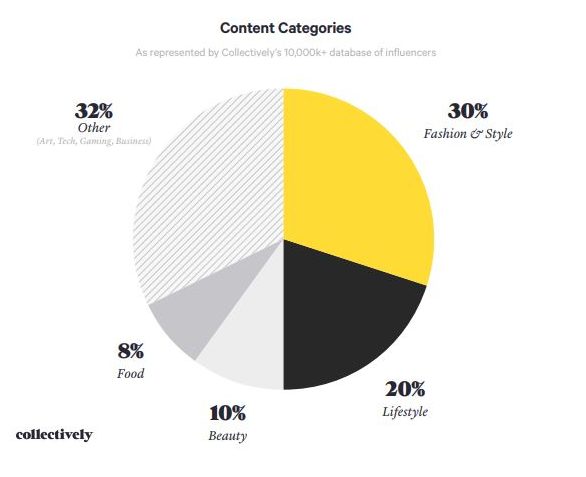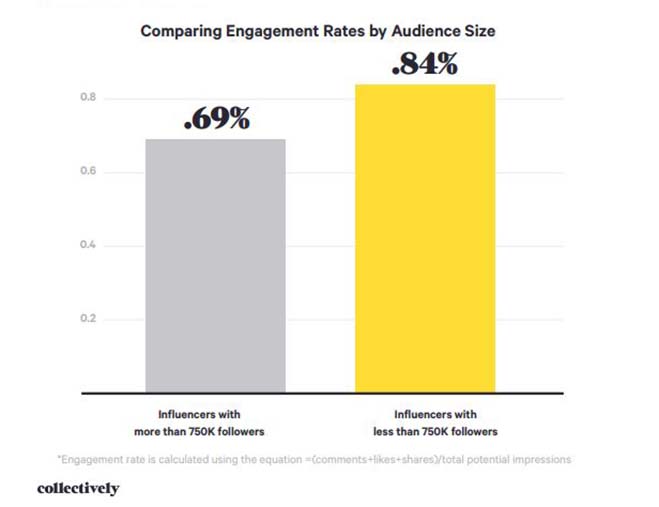Influencer marketing in 2018
We can no longer say influencer marketing is a buzzword. It has now firmly established itself as a marketing channel in its own right and looks set to come of age in 2018. With this maturity comes opportunities and challenges, both for brands looking for new ways to connect with their audiences and the influencers and content creators themselves, who are being held to more data-driven campaigns and expectations of results.
A new report by Collectively, entitled The Social Influence Business: 2018 and Beyond has examined this newly mature influencer marketing landscape, examining industry growth, campaign trends, the logistics of brand influencer partnerships, what happens after a campaign and what lies ahead. Here are a few of the key findings, to inform your own influencer efforts this year.
What is an influencer?
Before diving in to how you can leverage this channel, let’s quickly recap what an influencer actually is. With the emergence of macro and micro influencers and an ever-shifting landscape, this definition is perhaps not as clear cut as it once was. The Social Influence Business report has a concise interpretation;
“Today’s influencer ecosystem represents a diverse group of talented creative professionals who share their content and creativity online on a mix of different social platforms.”
Additionally, an influencer is someone with anything from 5000 to 1 million+ followers, with a specific interest, topic or skill.
There are certain industries that seem to produce prolific influencers. Fashion for example has the Blonde Salad – the first ever blogger to be the focus of a Harvard Business School Review, thanks in no small part to her partnerships with brands like Burberry and Prada, her growing fashion empire and estimated 7 million euros per year income from blogging.
The brainchild of The Blonde Salad is the Italian blogger, Chiara Ferragni. She launched her blog in 2010 and was one of the first to pioneer influencer marketing thanks to product placement with a number of brands (travel, fashion and cars to name but a few). She would weave those products into her blog, sharing images and experiences with her followers.
Today, around 30% of influencers operate in the fashion niche. The Collectively report pegs this as the single most popular category, ahead of lifestyle (20%), beauty (10%) and food (8%). The remaining influencer ecosystem covers a spectrum of topics, from art to gaming to business.
The business of being an influencer
As brands have switched on to having social media personalities with the ear of specific audiences create content around their product, the business of being an influencer has grown.
New content creators are springing up every day, eager to grab a piece of the growing influencer marketing budget and as a result, more and more people are able to turn ‘being an influencer’ into a viable career.
The Social Influence Business report concluded:
- 83% of influencers have experienced growth across their whole business model with increased in income, partnerships, audience figures and engagement levels.
- Over half (52%) of influencers have grown their digital audience.
- There is a growing band of influencers who treat their social profile or blog as a viable business, with a more strategic approach to brand partnerships and income streams.
The growth and value of micro-influencers
Micro-influencers in particular are beginning to benefit from the overall growth in influencer marketing – likely thanks in no small part to the fact that they are more affordable to brands eager to cash in on this trend. A micro-influencer is someone with an audience of around 5,000 -100,000 with a focus on a very specific niche.
At the dawn of influencer marketing, micro-influencers were overlooked, with their smaller audiences written off by brands who wanted partnerships with higher-profile content creators. Today, there has been a shift, and more and more, marketing teams are beginning to appreciate the value that comes from having a very engaged audience built around a very particular niche. Because they are smaller, micro-influencers tend to be closer to their followers, often resulting in a more loyal and engaged community.
Collectively concluded:
- Influencers with audiences of 10,000 – 100,000 are experiencing a particularly high period of growth with a 57% leap in revenue, brand partnership opportunities and audience.
- Influencers with 100,000 – 250,000 followers have seen a 19% growth in partnership, audience and revenue.
What do influencers look for?
With more power comes more choice and while influencers are facing increased expectations of return and engagement, they’re also facing more choice of brand partner. The overwhelming reason for passing on a brand partnership opportunity is financial, with influencers saying they will turn down partnership requests where the budget doesn’t align with expectations.
Over 6 in 10 (64%) of influencers will determine who they work with based on their connection to the product, with most saying their yardstick is whether they believe I the product or service and would be genuinely happy to use it.
The takeaway here is that influencers value authenticity and having worked hard to build their audience, they want to retain that trust by genuinely believing in the partners they promote.
Brand strategy
Income from brand partnerships is the single largest source of revenue for 83% of influencers. New content creators are emerging, technology is developing, and influencer marketing is maturing. This gives brands more scope to be creative and experimental and as a result, influencer marketing strategy is slowly coming to the fore.
Instagram tends to be the focus for influencer content with the highest level of brand spend on this platform but, there is a shift towards other activities with an increase in 2017 of social-only and brand sampling campaigns. This includes actions such as event attendance, product trials and product experiences.
Brands are also starting to see the value of setting influencer goals and using these in their selection of influencer. Collectively reports that a high-profile YouTube personality isn’t the right choice for a brand who wants to develop a long-term advocacy for example but great for a shot of instant awareness.
Micro-influencers tend to have more engagement so where KPIs are built around impressions, comments and clicks, a content creator with an audience below 750,000 followers is recommended. Collectively research suggests that engagement falls as audience size grows so weighing this up against KPIs is important.
The report shows that brands are increasingly taking a longer-term strategy, with 3-6 months the campaign sweet spot. Its research shows that on average, one post per month over three months will keep the influencer’s audience engaged. According to 54% of influencers, this approach is successful in keeping awareness and interest over time. 61% say there is an increase in positive brand comments over time with sponsored posts – the key takeaway here of course is that one and done isn’t the right methodology and a medium to long term relationship should be sought with the selected influencer(s) in order to see the returns desired.
The marketing mix
As influencer marketing has evolved, so to has its place in the marketing mix and this means influencer content is being used across multiple owned, earned and paid channels on a more regular basis. Collectively identifies influencer content distributed across;
- Paid amplification (promoted posts)
- Social ads
- Display and other paid ads
- Editorial content
- Point of sale promotion
- Email marketing
Within this marketing mix, social media is currently king. It plays a pivotal role in content distribution with many influencers working to connect their audiences across an array of social platforms (Instagram, Pinterest, Snap, Twitch, Twitter etc.).
Instagram reins supreme here, with 92% of influencers reporting more engagement on Instagram that Snapchat and the overwhelming majority favouring Instagram stories over Snap for limited-time content sharing. Snapchat has the edge for unfiltered, spontaneous content it seems but for those producing more editorial and pre-prepared content, Instagram Stories is the more effective choice. 69% of influencers use Instagram Stores exclusively and 78% say there’s more engagement via Stories than Snap.
There is little doubt of influencer marketing’s place in the overall digital marketing mix and, we expect this to only be more solidified and entrenched in the coming months. Because influencer marketing has come of age, many brands are now looking to take the next step in their own approach and that means more value and data driven campaigns with an expectation that influencers are more accountable for performance and engagement.
Read the full report from Collectively here.
Rebecca Appleton
MD

